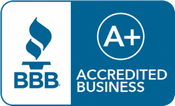
3 Options for Dealing With a Tax Bill
Published on April 10, 2017
We work so hard to avoid it, but occasionally, we have to deliver the dreaded news: “You owe money to the IRS.” It’s news we hate to share and know you hate to hear. Still, it happens. What can you do?
If you end up owing taxes, you may be inclined to panic. But don’t! There are several options available to you that can ease the sting of a tax bill.
- Pay now (or later).
You can opt to pay the IRS your total tax due by the April deadline (April 18th this year) via check or money order by mail (we’ll give you the address), or by credit or debit card. According to the IRS website, there are three payment processors that can accept tax payments, with credit card fees ranging from 1.87% to 2.00% of the payment amount. Keep in mind that your credit card company will also charge you interest should you carry the balance for more than 30 days.
Alternatively, as an individual owing less than $50,000, you can request a payment plan using form 9465, Installment Agreement Request, or online with the Online Payment Agreement Application. An installment plan allows you to stretch out payments for up to 72 months, though interest and penalties start accumulating after the April filing deadline. To get rid of the debt quickly, pay as much as you can up front, and as much as you can reasonably afford each month.
Whatever you do, don’t file an extension for the wrong reasons. Yes, submitting IRS form 4868 instead of your tax return can allow you a six-month extension, making your tax return due in October instead of April, but that doesn’t delay the date your tax bill is due. An extension is designed to give you extra time to gather information for your return, not delay payment. You can be charged interest and penalties on the unpaid balance if you don’t meet the April deadline.
- Make new investments.
Making new investments in retirement, education, and health care can significantly reduce the amount of your income that's subject to taxes. You’ll still have to come up with the money to invest, but at least you’ll be keeping more of your money for yourself in the long run -- instead of giving it to the IRS now.
Suggestions for lowering your tax bill include:
- Maximizing 401(k) contributions, particularly matching contributions.
The maximum amount an employee can contribute in 2017 to a 401(k) remains the same as it was in 2016: up to $18,000 or up to $24,000 for those age 50 and over. The same rules apply for 457 and 403(b) retirement plans. - Contributing to an IRA.
Both traditional and Roth IRAs allow contributions to grow tax free. In some situations, contributions to a traditional IRA are tax deductible. The AGI restriction for Roth IRAs in 2016 for single filers is $117,000 phasing out at $132,000; for the 2017 tax years the income phase-out range is $118,000 to $133,000. The restriction for married taxpayers filing jointly in 2016 starts at $184,000 and phases out at $194,000; for 2017, the range is $186,000 to $196,000. - Contributing to a 529 education savings plan.
529 plans allow you to make after-tax contributions to pay for college costs for your child or other family members. The contributions grow tax-deferred and the funds can be withdrawn tax-free if used for qualified college tuition and other expenses. - Opening or contributing to an HSA.
If you have a high deductible plan, a Health Savings Account (HSA) can allow you to make pre-tax contributions and take tax-free distributions to pay qualified medical expenses for yourself and family members covered under that high deductible plan. These distributions can be made at any time to pay for qualified medical expenses in the near-term or health care expenses in retirement. For 2016, the maximum amount an individual can contribute to an HSA is $3,350; it increases to $3,400 for 2017. For families in both the 2016 and 2017 tax years, the HSA contribution maximum is $6,750. If you're age 55 by the end of the tax year, you can make a catch-up contribution of $1,000.
- Donate your required minimum distribution to charity.
If you've saved a lot in a traditional IRA or similar tax-deferred retirement plans, then you'll have to start withdrawing some of the money when you turn 70½. These withdrawals are known as required minimum distributions, or RMDs.
When you take an RMD, it's taxed at your ordinary income tax rate. But if you don't need the RMD for day-to-day retirement expenses, then you can avoid the taxes on your mandated withdrawals by donating them directly to a qualified charity. You won't get a tax deduction for your donation (a QCD, qualified charitable distribution), but since you never take possession of the money, you won't owe taxes on it. Note: This option has the added bonus of making you feel warm and fuzzy.
Your BGW tax professional can help you determine the best course of action for your particular situation. If you get the “dreaded call”, know that we’ll be armed with a variety of options to help make it easier for you. In addition, let’s get to work on next year to more accurately predict your total tax burden and divide up your total amount due into quarterly estimated payments you can make to the IRS. A little preparation can avoid the surprise of another tax bill down the road.






